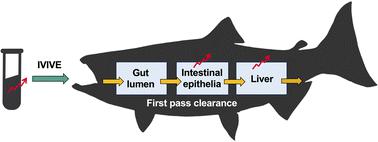当前位置:
X-MOL 学术
›
Environ. Sci.: Processes Impacts
›
论文详情
Our official English website, www.x-mol.net, welcomes your
feedback! (Note: you will need to create a separate account there.)
An amended in vitro–in vivo extrapolation model that accounts for first pass clearance effects on chemical bioaccumulation in fish
Environmental Science: Processes & Impacts ( IF 4.3 ) Pub Date : 2023-02-21 , DOI: 10.1039/d2em00522k Leslie J Saunders 1 , John W Nichols 2 , Jon A Arnot 1, 3 , James M Armitage 4 , Frank Wania 1
Environmental Science: Processes & Impacts ( IF 4.3 ) Pub Date : 2023-02-21 , DOI: 10.1039/d2em00522k Leslie J Saunders 1 , John W Nichols 2 , Jon A Arnot 1, 3 , James M Armitage 4 , Frank Wania 1
Affiliation

|
Measured rates of in vitro intrinsic clearance for fish may be extrapolated to the whole animal as a means of estimating a whole-body biotransformation rate constant (kB; d−1). This estimate of kB can then be used as an input to existing bioaccumulation prediction models. Most in vitro–in vivo extrapolation/bioaccumulation (IVIVE/B) modeling efforts to date have focused on predicting the chemical bioconcentration in fish (aqueous only exposure), with less attention paid to dietary exposures. Following dietary uptake, biotransformation in the gut lumen, intestinal epithelia, and liver can reduce chemical accumulation; however, current IVIVE/B models do not consider these first pass clearance effects on dietary uptake. Here we present an amended IVIVE/B model that accounts for first pass clearance. The model is then used to examine how biotransformation in the liver and intestinal epithelia (alone or combined) may impact chemical accumulation that occurs during dietary exposure. First pass clearance by the liver can greatly reduce dietary uptake of contaminants, but these effects are only apparent at rapid rates of in vitro biotransformation (first order depletion rate constant kDEP ≥ 10 h−1). The impact of first pass clearance becomes more pronounced when biotransformation in the intestinal epithelia is included in the model. Modelled results suggest that biotransformation in the liver and intestinal epithelia cannot entirely explain reduced dietary uptake reported in several in vivo bioaccumulation tests. This unexplained reduction in dietary uptake is attributed to chemical degradation in the gut lumen. These findings underscore the need for research to directly investigate luminal biotransformation in fish.
中文翻译:

一种修正的体外-体内外推模型,解释了鱼类化学生物积累的首过清除效应
作为估计全身生物转化速率常数 (k B ; d -1 ) 的一种手段,可以将测量的鱼类体外固有清除率外推到整个动物。然后可以将k B的估计值用作现有生物累积预测模型的输入。大多数体外-体内外推/迄今为止,生物蓄积 (IVIVE/B) 建模工作的重点是预测鱼类中的化学生物浓度(仅接触水),较少关注饮食接触。饮食摄取后,肠腔、肠上皮细胞和肝脏中的生物转化可以减少化学物质的积累;然而,当前的 IVIVE/B 模型并未考虑这些首过清除效应对膳食摄取的影响。在这里,我们提出了一个修正的 IVIVE/B 模型,该模型考虑了首次通过许可。然后使用该模型检查肝脏和肠上皮细胞(单独或组合)中的生物转化如何影响饮食暴露期间发生的化学积累。肝脏的首过清除率可以大大减少污染物的饮食摄入,但这些影响仅在体外快速代谢时才明显生物转化(一级消耗率常数k DEP ≥ 10 h -1)。当模型中包括肠上皮细胞的生物转化时,首过清除的影响变得更加明显。模拟结果表明,肝脏和肠上皮细胞中的生物转化不能完全解释几个体内生物蓄积试验中报告的饮食摄取减少。这种无法解释的饮食摄取减少归因于肠腔中的化学降解。这些发现强调需要进行研究以直接研究鱼类的管腔生物转化。
更新日期:2023-02-21
中文翻译:

一种修正的体外-体内外推模型,解释了鱼类化学生物积累的首过清除效应
作为估计全身生物转化速率常数 (k B ; d -1 ) 的一种手段,可以将测量的鱼类体外固有清除率外推到整个动物。然后可以将k B的估计值用作现有生物累积预测模型的输入。大多数体外-体内外推/迄今为止,生物蓄积 (IVIVE/B) 建模工作的重点是预测鱼类中的化学生物浓度(仅接触水),较少关注饮食接触。饮食摄取后,肠腔、肠上皮细胞和肝脏中的生物转化可以减少化学物质的积累;然而,当前的 IVIVE/B 模型并未考虑这些首过清除效应对膳食摄取的影响。在这里,我们提出了一个修正的 IVIVE/B 模型,该模型考虑了首次通过许可。然后使用该模型检查肝脏和肠上皮细胞(单独或组合)中的生物转化如何影响饮食暴露期间发生的化学积累。肝脏的首过清除率可以大大减少污染物的饮食摄入,但这些影响仅在体外快速代谢时才明显生物转化(一级消耗率常数k DEP ≥ 10 h -1)。当模型中包括肠上皮细胞的生物转化时,首过清除的影响变得更加明显。模拟结果表明,肝脏和肠上皮细胞中的生物转化不能完全解释几个体内生物蓄积试验中报告的饮食摄取减少。这种无法解释的饮食摄取减少归因于肠腔中的化学降解。这些发现强调需要进行研究以直接研究鱼类的管腔生物转化。











































 京公网安备 11010802027423号
京公网安备 11010802027423号